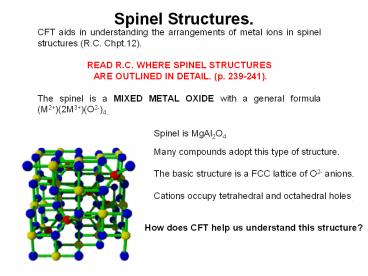Spinel Structures. PowerPoint PPT Presentation
Title: Spinel Structures.
1
Spinel Structures.
CFT aids in understanding the arrangements of
metal ions in spinel structures (R.C. Chpt.12).
READ R.C. WHERE SPINEL STRUCTURES ARE OUTLINED
IN DETAIL. (p. 239-241). The spinel is a MIXED
METAL OXIDE with a general formula
(M2)(2M3)(O2-)4..
Spinel is MgAl2O4 Many compounds adopt this type
of structure. The basic structure is a FCC
lattice of O2- anions. Cations occupy
tetrahedral and octahedral holes.
How does CFT help us understand this structure?
2
Spinel structures and CFT
Normal Spinal Structure. M2 is tetrahedral, M3
is octahedral Example (Mg2)T(2Al3)O(O2-)4 In
verse Spinal Structure. M2 is octahedral M3 is
tetrahedral and in the remaining octahedral holes
Example (Fe3)T(Fe2,Fe3)O(O2-)4
This later example is magnetite or Fe3O4.
Fe3O4 (Fe2, 2Fe3, 2O2-) Note the O2- is a
weak field ligand. (Fe is H.S.) What are the
electron configurations of the Fe ions?
Fe0 is d8
Fe2
OR
3
Mn3O4 Spinel Structure.
Mn3O4 (Mn2, 2Mn3, 4O2-)
Electron configurations are .. ?
OR
4
How does CFT measure up?
I. Colours of Transition Metal Complexes
Why are most transition metal complexes brightly
coloured but some aren't? Why do the colours
change as the ligand changes? Why do the colours
change as the oxidation state of the metal
changes, even for complexes of the same ligand?
II. Why do different complexes of the same metal
ion in the same oxidation state have
different numbers of unpaired electrons? Why
are there only certain values of the number of
unpaired electrons for a given metal ion?
III. Why do some transition metal ions seem to
have a fixed coordination number and
geometry, while other metal ions seem variable?
IV. Why do some metal complexes undergo
ligand-exchange reactions very rapidly and
other similar complexes react very slowly, yet
this reaction is thermodynamically
favorable?
5
Course Outline
- Introduction to Transition Metal Complexes.
- Classical complexes (Jorgenson and Werner)
- Survey of ligand coordination numbers,
geometries and types of ligands - Nomenclature
- Isomerism
- Bonding in Transition Metal Complexes.
- Electron configuration of transition metals
- Crystal field theory
- Valence bond theory
- Simple Molecular Orbital Theory
- Electronic Spectra and Magnetism
- Kinetics and Mechanisms of Inorganic Reactions.
- Stability and lability
- Substitution reactions
- Electron transfer reactions
- Descriptive Chemistry of TMs.
- Organometallic Chemistry
- 18 e- rule, ?, and ? bonding ligands
(synergistic bonding) - Metal carbonyls, synthesis, structure,
reactions

